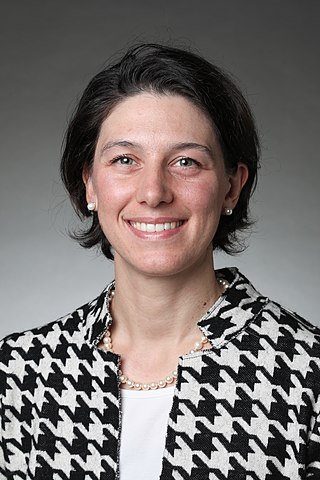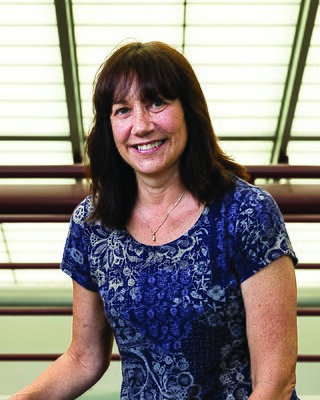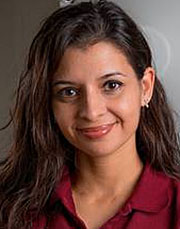
Argonne National Laboratory is a federally funded research and development center in Lemont, Illinois, United States. Founded in 1946, the laboratory is owned by the United States Department of Energy and administered by UChicago Argonne LLC of the University of Chicago. The facility is the largest national laboratory in the Midwest.
The Center for Nanophase Materials Sciences is the first of the five Nanoscale Science Research Centers sponsored by the United States Department of Energy. It is located in Oak Ridge, Tennessee and is a collaborative research facility for the synthesis, characterization, theory/ modeling/ simulation, and design of nanoscale materials. It is co-located with Spallation Neutron Source.

The National Synchrotron Light Source II (NSLS-II) at Brookhaven National Laboratory (BNL) in Upton, New York is a national user research facility funded primarily by the U.S. Department of Energy's (DOE) Office of Science. NSLS-II is one of the world's most advanced synchrotron light sources, designed to produce x-rays 10,000 times brighter than BNL's original light source, the National Synchrotron Light Source (NSLS). NSLS-II supports basic and applied research in energy security, advanced materials synthesis and manufacturing, environment, and human health.

Thermal scanning probe lithography (t-SPL) is a form of scanning probe lithography (SPL) whereby material is structured on the nanoscale using scanning probes, primarily through the application of thermal energy.
In situ electron microscopy is an investigatory technique where an electron microscope is used to watch a sample's response to a stimulus in real time. Due to the nature of the high-energy beam of electrons used to image a sample in an electron microscope, microscopists have long observed that specimens are routinely changed or damaged by the electron beam. Starting in the 1960s, and using transmission electron microscopes (TEMs), scientists made deliberate attempts to modify materials while the sample was in the specimen chamber, and to capture images through time of the induced damages.

Liquid-phase electron microscopy refers to a class of methods for imaging specimens in liquid with nanometer spatial resolution using electron microscopy. LP-EM overcomes the key limitation of electron microscopy: since the electron optics requires a high vacuum, the sample must be stable in a vacuum environment. Many types of specimens relevant to biology, materials science, chemistry, geology, and physics, however, change their properties when placed in a vacuum.

Amanda Karen Petford-Long is a Professor of Materials Science and Distinguished Fellow at the Argonne National Laboratory. She is also a Professor of Materials Science at Northwestern University.
Caterina Ducati is a Professor of Nanomaterials in the Department of Materials at the University of Cambridge. She serves as Director of the University of Cambridge Master's programme in Micro- and Nanotechnology Enterprise as well as leading teaching in the Nanotechnology Doctoral Training Centre.

Giulia Tagliabue is an Italian engineer specialized in nanophotonics. She is a professor at EPFL's School of Engineering, where she leads the Laboratory of Nanoscience for Energy Technologies (LNET).
Ursel Bangert is the Bernal Chair in Microscopy and Imaging at the University of Limerick as well as a Lecturer at the University of Manchester, of Research Fellow at Surrey University, and of PhD student at the Universität Köln. She develops advanced characterisation techniques such as transmission electron microscopy for the atomic scale imaging of novel materials. Her research outcomes include achievement of TEM imaging and electron energy loss spectroscopy on the sub-atomic scale to reveal structure and dynamics of individual atoms
Katherine Jungjohann is a group leader at the National Renewable Energy Laboratory (NREL) and previously worked as a scientist and engineer at the Center for Integrated Nanotechnologies (CINT) which is part of Sandia National Laboratories in Albuquerque, New Mexico, United States.

Miaofang Chi is a distinguished scientist at the Center for Nanophase Materials Sciences in Oak Ridge National Laboratory. Her primary research interests are understanding interfacial charge transfer and mass transport behavior in energy and quantum materials and systems by advancing and employing novel electron microscopy techniques, such as in situ and cryogenic scanning transmission electron microscopy. She was awarded the 2016 Microscopy Society of America Burton Medal and the 2019 Microanalysis Society Kurt Heinrich Award. She was named to Clarivate's list of Highly Cited Researchers in 2018 and 2020.
Haimei Zheng is a Chinese-American materials scientist who is a senior scientist in Materials Sciences Division at the Lawrence Berkeley National Laboratory. She is an adjunct professor in Department of Materials Science and Engineering at the University of California, Berkeley. Her research considers the nucleation, nanoscale materials transformations, and dynamic phenomena at solid-liquid interfaces, which she studies by developing the advanced in situ electron microscopy techniques. She is a Fellow of the Materials Research Society.

Julia Laskin is the William F. and Patty J. Miller Professor of Analytical Chemistry at Purdue University. Her research is focused on the fundamental understanding of ion-surface collisions, understanding of phenomena underlying chemical analysis of large molecules in complex heterogeneous environments, and the development of new instrumentation and methods in preparative and imaging mass spectrometry.

Zhong Lin Wang is a Chinese-American physicist, materials scientist and engineer specialized in nanotechnology, energy science and electronics. He received his PhD from Arizona State University in 1987. He is the Hightower Chair in Materials Science and Engineering and Regents' Professor at the Georgia Institute of Technology, US.
Teresa Pellegrino is an Italian chemist who is Professor of Chemistry at the Istituto Italiano di Tecnologia. Her research considers nanomaterials for biomedical applications. She was appointed Associate Editor of Nanoscale in 2022.

Karren L. More is an American materials scientist who is the Director of the Center for Nanophase Materials Sciences at the Oak Ridge National Laboratory. Her research considers advanced electron microscopy as a probe to understand the structure and chemistry of emerging materials. More is a Fellow of the American Ceramic Society and Microscopy Society of America.

Jana Zaumseil is a German chemist who is a professor of physical chemistry at Heidelberg University. She serves as dean of the faculty of chemistry and earth sciences. Her research considers organic electronic materials for optoelectronics.

Shelley Claridge is an American chemist who is an associate professor of chemistry at Purdue University. Her research considers the design of nanostructured materials and better understanding their physical and chemical properties. She was awarded a Schmidt Science Polymaths Award in 2022 and the American Chemical Society Women Chemists Committee Rising Star Award in 2023.
Tijana Rajh is American materials scientist who is a professor and director of the Arizona State University School of Molecular Sciences. Her research considers the development of nanomaterials and materials for quantum technologies. She was awarded the Association for Women in Science Innovator Award in 2009, and named a Fellow of the American Association for the Advancement of Science in 2014.












